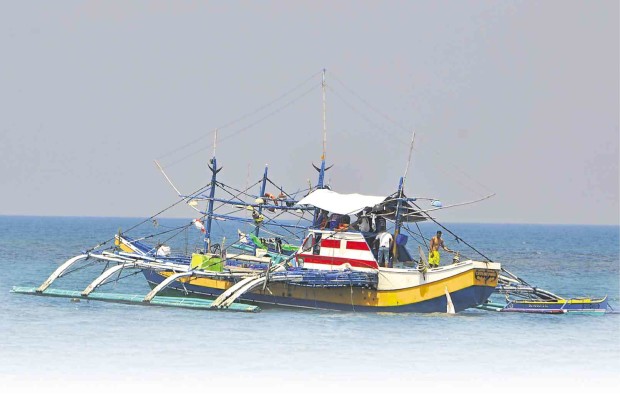PH fishermen bear brunt of Scarborough tension

CREWMEN of a fishing boat relax after a trip to the West Philippine Sea. WILLIE LOMIBAO/INQUIRER NORTHERN LUZON
INFANTA, Pangasinan—For more than a month now, Carlo Montehermozo had not returned to the Scarborough Shoal in the West Philippine Sea for a fishing trip.
He used to sail there at least twice a month like other fishermen in the village of Cato here, taking the risk of being chased away by Chinese coast guards who had been patrolling Philippine maritime territory.
Because more Chinese Navy and Coast Guard ships have started guarding the area, Montehermozo said fishing boats are no longer allowed to sail even near the shoal.
“It has been difficult for us,” Montehermozo said. “Fishing is the only livelihood we know.”
The Scarborough Shoal, also known as Panatag Shoal and Bajo de Masinloc, is 260 kilometers from this town. It is a rich fishing ground and has served as a mid-sea refuge for fishing boats during stormy weather at sea until the Chinese began patrolling the area in 2012.
Article continues after this advertisementAbout 80 percent (or 3,703) of Cato’s 4,629 residents are fishermen, most of them working as crew members of commercial fishing boats.
Article continues after this advertisementBecause no boat has left the shoal, many fishermen are idle, said Cato village chair Charlito Maniago.
Some fishermen turn to the “payao” (artificial reef) scattered in the West Philippine Sea.
“But it’s a big gamble when they go there. They are not sure if there are fish in the payao,” said Maniago.
A payao is made of small bamboo rafts fitted with palm leaves to attract small fish, which feed on plankton that settle on the fronds. Big fish, like tuna, are in turn attracted to the payao by the small fish.
Maniago said Metro Manila-based owners of payao visit the artificial reefs regularly to harvest.
But Montehermozo said income from the payao is barely enough for the needs of his family.
“If you’re lucky, maybe you will earn more,” he said.
A fisherman from Bolinao said he usually earns P6,000 from fishing in the payao. But there are days when he would earn only P1,000.
At Scarborough Shoal, Maniago said, fishermen are assured of bigger income by the abundance of fish.
Wilfredo Nantes, a fishing boat operator, said fishermen would risk being harmed by Chinese patrols in Scarborough because they were sure of recovering expenses of up to P60,000 per fishing trip.
Montehermozo said he hoped President Duterte would fulfill a promise to reclaim the shoal. The Philippines has challenged China’s claims over nearly the entire South China Sea, and is expecting a ruling next week from the United Nations Arbitral Tribunal in The Hague.
Even if the court decision favored the Philippines, Montehermozo said he is not optimistic that China would leave the shoal.
“I hope that even if the Chinese are there, they will allow us to fish freely. It’s the only thing we want to do there,” he said.